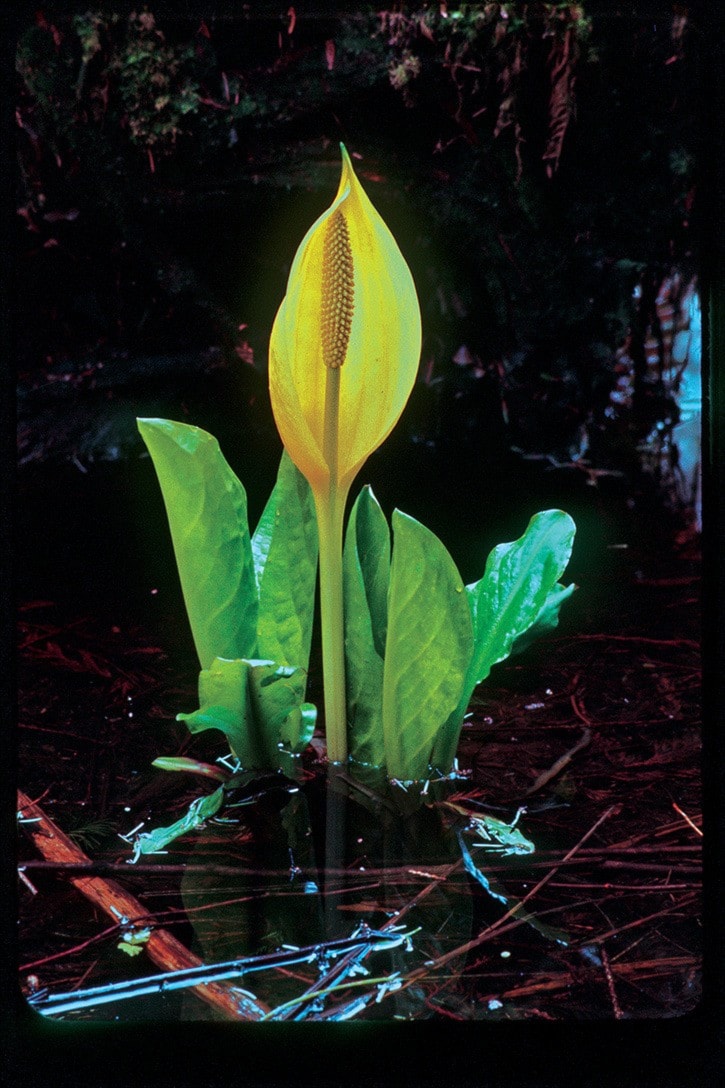By Dr. Richard Hebda / Royal B.C. Museum
Many native B.C. alpine plants such as mountain sorrell (Oxyria digyna) connect our flora to the tundra and high mountains of Asia. In the lowlands there are fewer species in common between these two continents.
Among these plants is one of the most remarkable in our province, the skunk cabbage (Lysichiton americanus), known also as tellow arum and by the more evocative names of swamp lantern and Skeena lily.
This robust perennial forms modest to luxurious clumps of leaves reminiscent of the tropics. It is best known for the large yellow blooms that light up damp forest corners in the spring time.
Skunk cabbage grows from a short thick underground root-stem (rhizome). Numerous large white roots anchor the plant firmly in the muck. Huge egg- to lance-shaped leaves arise vertically from the rhizome. The leaves are usually shiny, bright green and waxy, but some populations are marked by dark blotches. The short leaf stalk is thick and succulent. Leaves unfurl in spring and remain up until late summer to fall when they flop onto the ground and die back.
Skunk cabbage is widespread in the coastal zone of northwest North America from the Aleutian Islands of Alaska to northern California. Scattered populations also occur inland of the Coast Mountains from Washington State to the Peace River country of B.C.
Typical habitats include bogs and bog edges, swamps dominated by deciduous and coniferous trees, sloughs, ditches and lakeshores.
Magnificent stands of skunk cabbage crowd the channels and back swamps of the Fraser River in the Lower Mainland. The species loves wet places both shaded and sunny. The largest plants inhabit shady sites along streams, but flowering plants are most abundant in open settings.
B.C. First Nations used the leaves to wrap food, much in the way we use wax paper today. Leaves were also used to line berry baskets and steaming pits.
Ancient stories recall the importance of the roots, many times cooked and washed, as famine food before the coming of spring salmon. The leaves should never be chewed or eaten because they contain highly irritating calcium oxalate crystals. Leaf and root poultices were once widely used to treat conditions such as swellings, boils, burns and sores.
A sister species of our skunk cabbage, Asian skunk cabbage (Lysichiton camtschatcensis) graces the wetlands of Pacific east Asia from the Kamchatka Peninsula to northern Japan. It is also known as white skunk cabbage because of the flower colour.
Asian skunk cabbage has been considered the same species as ours by some botanists, but generally does not grow quite as tall.
Like our plants the Asian skunk cabbages often emit a strong, somewhat unpleasant, odour; however, some populations reputedly smell sweet.
Although this species behaves itself well in its native territory, our skunk cabbage has proven to be a serious invader in northwest Europe. Having escaped their gardens it now clogs streams and other water ways in Scotland and England and is subject to eradication efforts.
As a final note, our native skunk cabbage connects us not only across the Pacific but also to the tropical island of Sumatra in Indonesia. Sumatra is the native home of the Titan arum (Amorphophallus titanum) also of the Arum family, that produces the largest unbranched flower head in the world, up to 3.7 metres tall. This botanical monster also has that skunky “fragrance.”
Our species can only be described as slightly scented or evenly pleasant in comparison.
•••
Dr. Richard Hebda is the curator of botany and earth history at the Royal B.C. Museum. He would like to acknowledge Ken Marr and Erica Wheeler who provided useful advice and review of this article.
